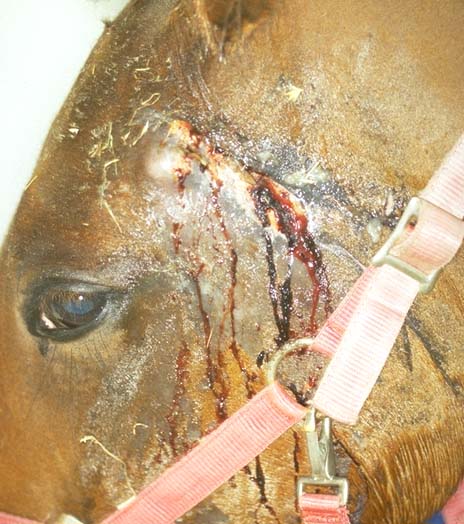Facial nerve: trauma
Introduction
- Damage of the facial nerve is very common.
- Cause: trauma, injury to the side of the face
 or a tight halter.
or a tight halter. - Signs: deviation of muzzle, abnormal prehension, ptosis and ear drop.
- Diagnosis: loss of nerve function.
- Treatment: DMSO, corticosteroids, surgery.
- Prognosis: good to fair.
Presenting signs
- Muzzle deviation away from the side of the lesion.
- Ptosis.
- Ear drop.
- Facial paralysis.
- Nystagmus.
- Circling.
- Tear production may be decreased.
- Depression.
- Decreased flaring of the ipsilateral nostril during inspiration.
- Extensive loss of motor function.
- Upper and lower lip drawn to functioning/normal side.
Geographic incidence
- Worldwide.
Age predisposition
- Horses of all ages.
Breed/Species predisposition
- Any breed.
- Heavy breeds in particular - if recumbent, may bang face on ground.
Pathogenesis
Etiology
- Facial nerve injury occurs secondary to:
EitherTrauma.
OrCompression.
OrInflammation of the nerve as it courses through the middle ear, the dorsal aspect of the guttural pouch, the ventral ramus of the mandible, and ventral to the facial crest. - Proximal facial nerve or facial nuclei injuries may be caused by equine protozoal myelitis, aberrant parasite migration, and cranial trauma.
- Fractures of the petrous temporal bone or hemorrhage into the middle ear, otitis media/interna, arthritis of the temporohyoid joint, guttural pouch mycosis, parotid lymph node abscessation, or fractures of the vertical ramus of the mandibular can also lead to proximal facial nerve injury.
- Distal facial nerve injury may be a result of blunt trauma to the side of the face, tight halters, and recumbency from anesthetic procedures.
Pathophysiology
- The facial nerve provides motor function to the muscles of facial expression, ie NOT the masster muscles.
- Signs are due to alteration or loss of motor function to muscles of facial expression.
- The facial nerve can be injured to various degrees of severity: neurapraxia is loss of function only; axonotmesis is loss of axons; neurotmesis is severance of axons and their nerve sheaths.
- Damage:
EitherAt the base of brain.
OrGuttural pouch.
OrHyoid bone.
OrMandible. - Injury results in a loss of muscle tone on the affected side.
- The loss of function may affect the auricular muscles, the orbicularis occuli muscle, the buccal muscles, or the muscles of the upper lip, nostrils, lower lip or chin, depending on the location of the injury.
- Closed trauma to the side of the face usually results in degrees of neurapraxia and axonotmesis.
- Neurotmesis occur with open wounds to the side of the face and with fractured temporal bones.
Timecourse
Neurapraxia- Function normally returns within 14 days, and often does so abruptly.
Axonotmesis
- Requires that the damaged axons regrow down the Schwann cell sheaths.
- It can take 6 months for recovery from this type of injury.
- The quality of recovery is never 100%.
- When no skin is lacerated, functional recovery usually is obtained.
Neurotmesis
- Depending on alignment of the damaged nerve fibers and depending on the degree of local tissue reaction, a proportion of the damaged fibers may regrow to their respective muscles of facial pression in 6-12 months; however this does not result in full return of function.
- Atrophy of the masseter can seriously interfere with food ingestion → recovery is signaled by a gradual improvement in the animal's ability to feed.
Diagnosis
Subscribe To View
This article is available to subscribers.
Try a free trial today or contact us for more information.
Treatment
Subscribe To View
This article is available to subscribers.
Try a free trial today or contact us for more information.
Prevention
Subscribe To View
This article is available to subscribers.
Try a free trial today or contact us for more information.
Outcomes
Subscribe To View
This article is available to subscribers.
Try a free trial today or contact us for more information.
Further Reading
Publications
Refereed papers
- Recent references from PubMed and VetMedResource.
- Kol A & Kelmer G (2014) A novel surgical technique for treating bilateral nasal paralysis in a mare. Equine Vet Educ 26 (11), 577-579 VetMedResource.
- De Fourmestraux C, Tessier C & Touzot-Jourde G (2014) Multimodal therapy including electroacupuncture for the treatment of facial nerve paralysis in a horse. Equine Vet Educ 26 (1), 18-23 VetMedResource.
- Hahn C (2008) Common peripheral nerve disorders in the horse. In Pract 30 (6), 322-329 VetMedResource.
- Cohen N D (1993) Neurologic evaluation of the equine head and neurogenic dysphagia. Vet Clin North Am Equine Pract 9 (1), 199-212 PubMed.
- Mordansky P, Welker B & Pickett J P (1989) Management of facial injuries. Vet Clin North Am Equine Pract 5 (3), 665-682 PubMed.